
The majestic and refined Grand Peterhof Palace is one of the most famous and visited places in St. Petersburg.
The construction of the palace began under Peter I. Over the course of history, the palace has undergone changes - it has become larger and more elegant. It was destroyed during the Second World War, then restored according to drawings, materials and technologies of the 18th century. Now the palace appears as it was created by the architect Bartolomeo Francesco Rastrelli in the 18th century.
Today, the Grand Peterhof Palace is a museum, part of the complex of the Palace and Park Ensemble "Peterhof" in Peterhof (St. Petersburg).
The palace is located on a terrace and occupies a dominant position in the composition of the ensemble, which also includes Upper Garden and Lower Park. Learn more about the Grand Peterhof Palace...
In the palace (for a fee) you can visit some of the museum rooms: the halls of the Peterhof Palace, a special storeroom, the Church Building and the fountain Museum. Each museum can be visited for a fee.
This article will focus on the museum "halls of the Great Peterhof Palace".

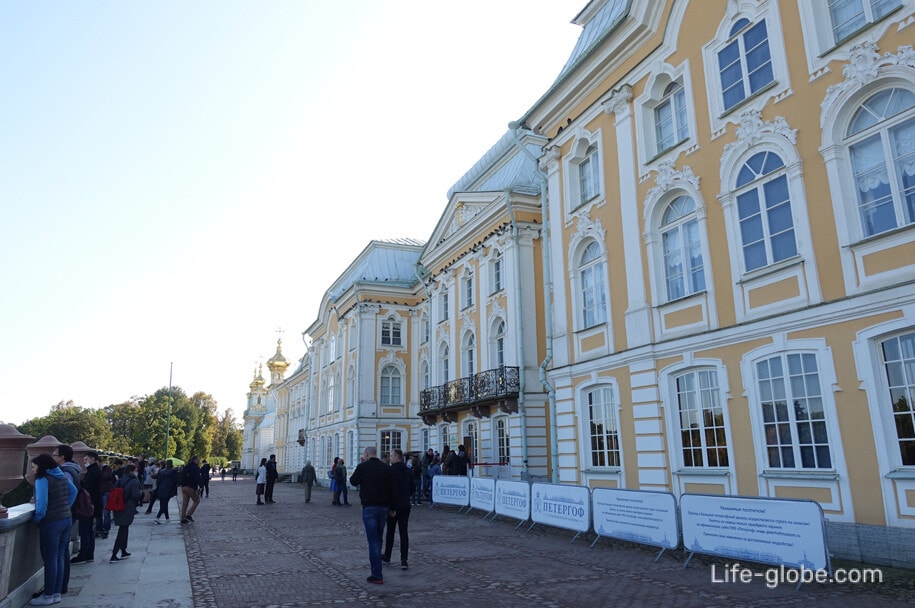
Although the Peterhof Palace looks impressive and wide from the outside, when you get inside, you actually see that it is quite small and narrow. In total, there are about 30 halls in the walls of the palace, among which there are magnificent state halls decorated with mirrors, parquet, stucco, "gold" and paintings; as well as the grand staircase, offices, reception rooms, dining rooms, the throne room, the private chambers of emperors and empresses.
When visiting the halls of the Grand Palace, guests can take a walk through the restored halls of the Former Peterhof Palace, while learning the history of the palace and seeing some decorative and applied art items, furniture and works of sculpture and painting located in the halls of the palace museum.

Guests of the palace, where receptions, balls, masquerades and festivals were held under the emperors and empresses, ascended to the halls of the palace by the Grand Staircase, which is located in the western wing of the palace.
In the 18th century, the staircase was wooden, and today it is wooden.
The staircase and the surrounding decoration are decorated in a festive style: the walls are decorated with paintings and gilded wooden carvings based on Rastrelli's drawings.

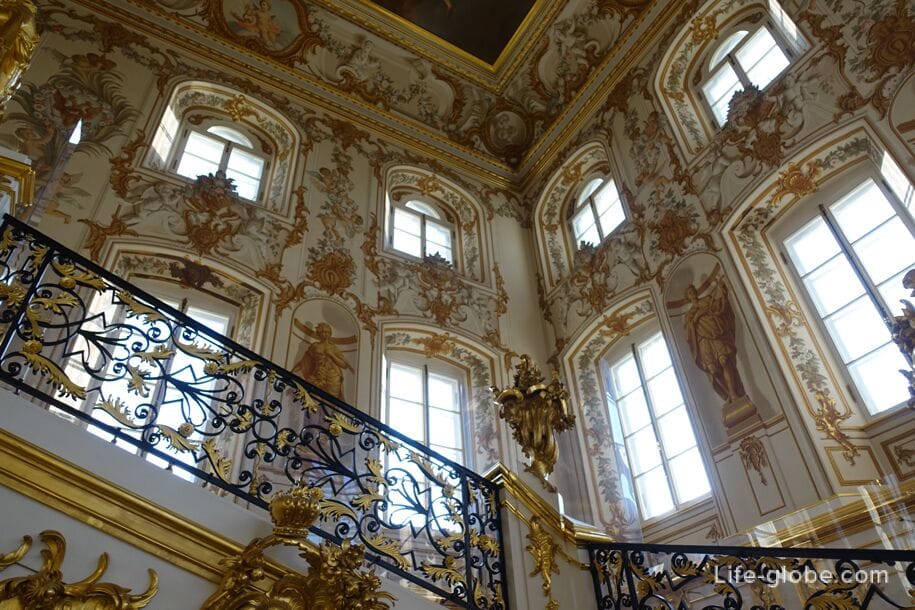
On the landing of the second floor there are four figures of girls-allegories of the seasons: Spring, Summer (on the railing of the stairs), Autumn and Winter (opposite the first).
One of the sculptures (right near the window) is an authentic sculpture of the 18th century.

The ceiling of the Grand Staircase is decorated with a painting (plafond) "Allegory of Spring" by Bartolomeo Tarsia.
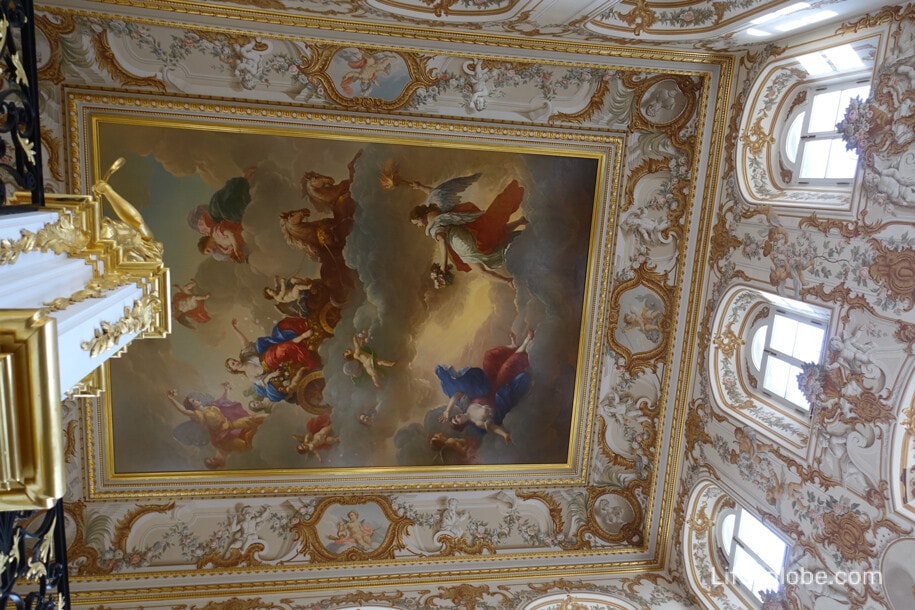
The door portal on the second floor of the staircase leading to the Dance Hall is made in the form of a triumphal arch and is decorated with a monumental desudeport with the figures "Loyalty" and "Justice".
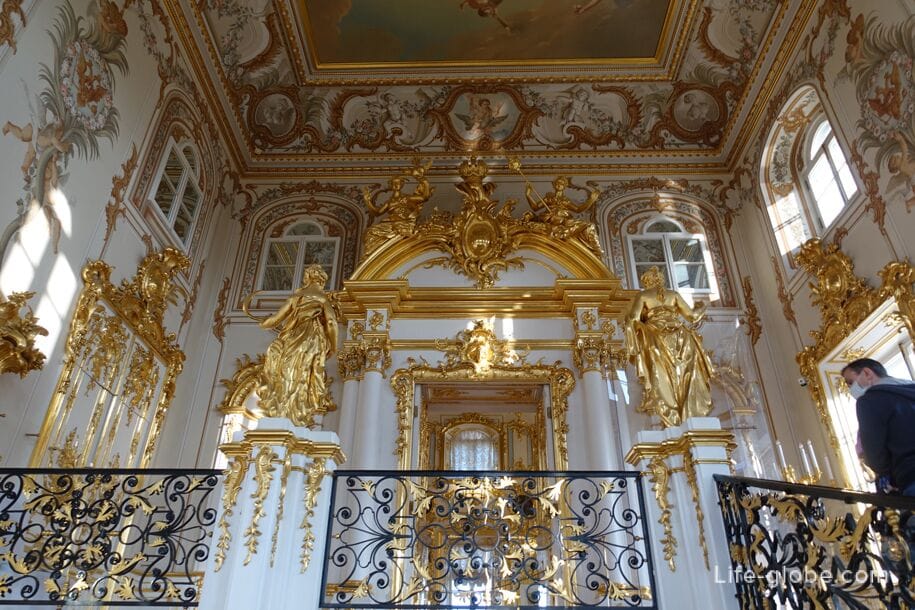
The Dance Hall, which is also known as the Merchant's Hall and where court balls began in the 18th century, is decorated with gilded (a thin layer of gold leaf, which is 5 microns thick) wooden carvings based on Rastrelli's drawings.
In the hall opposite each other in the piers are mirrors, this is a favorite technique of the architect Rastrelli, which endlessly repeats the space and visually expands the boundaries of the hall.
Above the mirrors and windows are 16 round paintings (tondo), originally created by the artist Giuseppe Valeriani, depicting illustrations for the books "Aeneid" by Virgil and "Metamorphoses" by Ovid. 4 of the 16 tondo are original works from the 18th century.
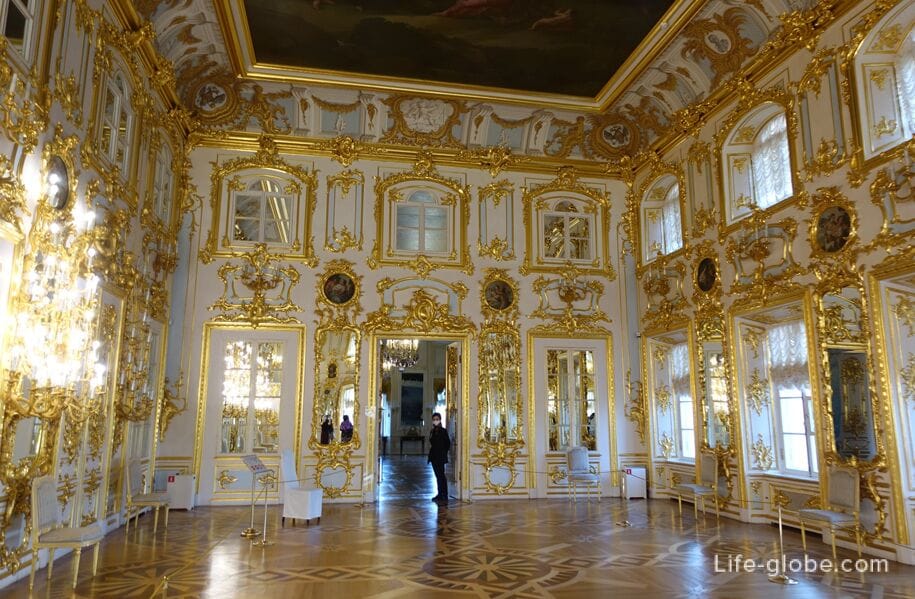
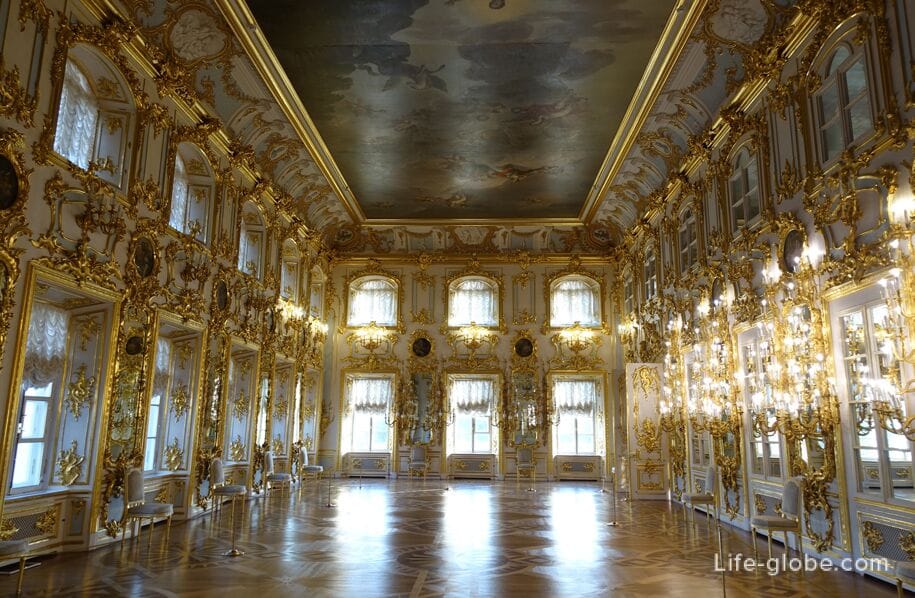
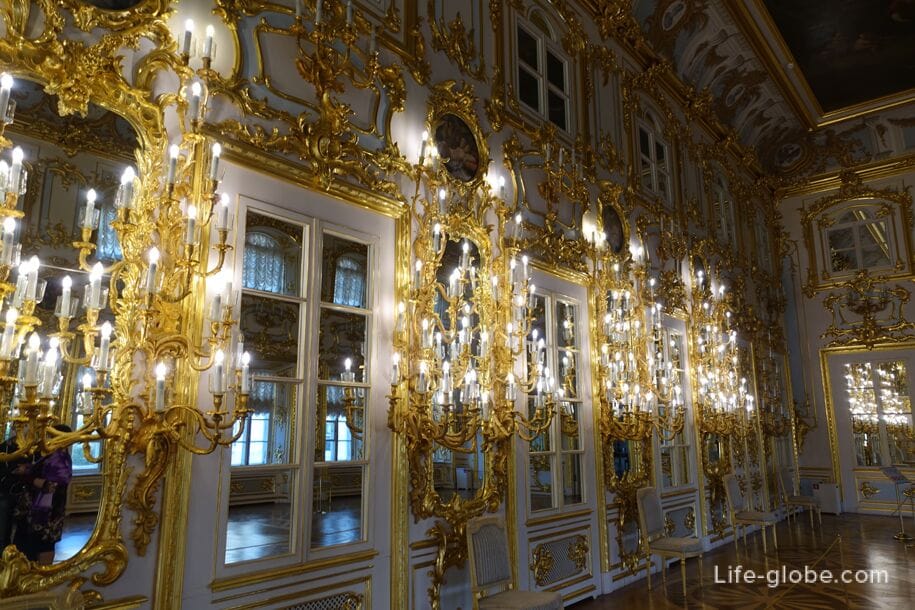
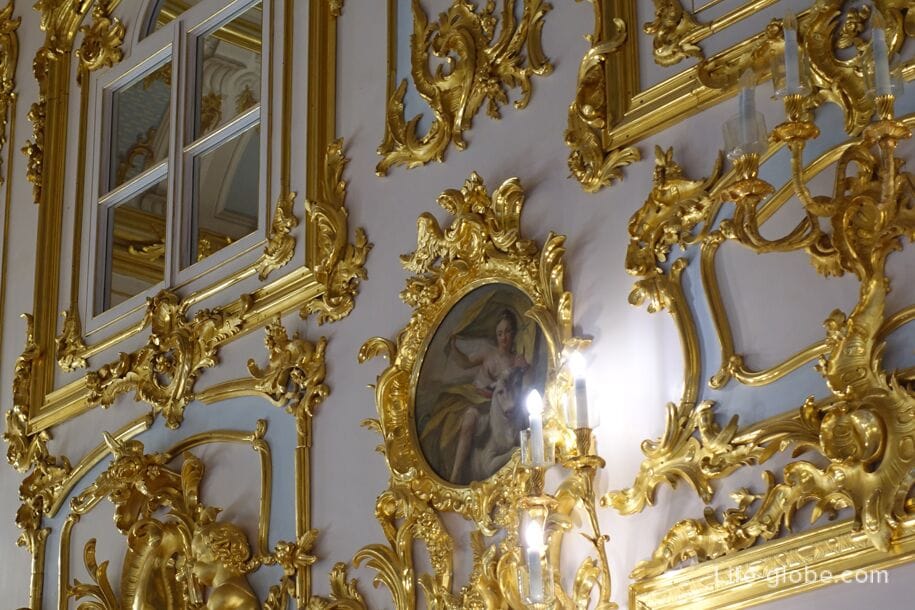
On the ceiling of the hall, according to the tradition of the Baroque era, there is a plafond in which the goddess Juno is depicted, in the image of which the artist wanted to allegorically (allegorically) show the very mistress of the palace-the Empress Elizabeth Petrovna (daughter of Peter I).
In the center of the painting is Mount Parnassus, the sun god surrounded by muses.
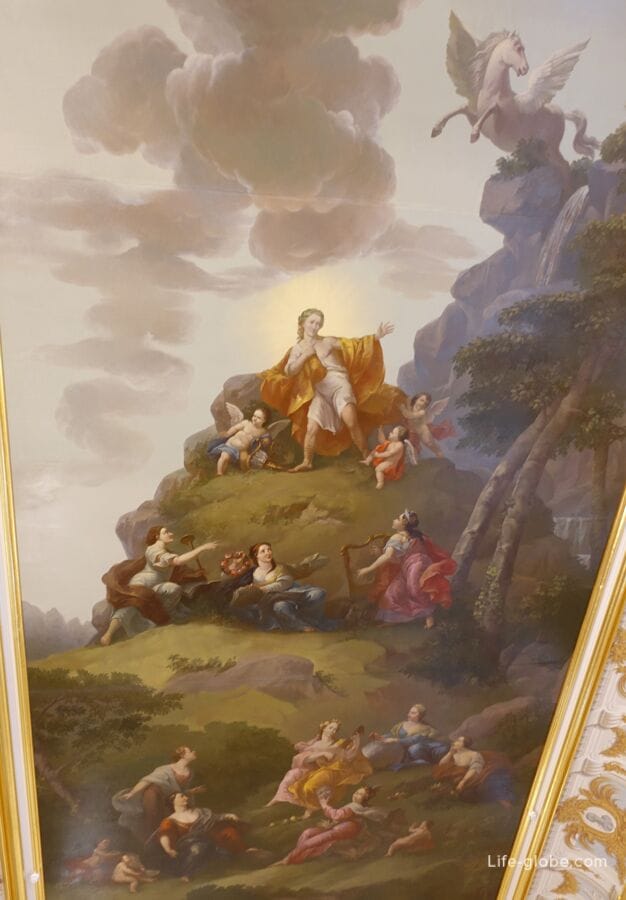
In this hall, Elizaveta Petrovna herself liked to dance. She had a good figure and liked to wear a man's suit, which fit her perfectly, emphasizing all the charms of her figure. But in the 18th century, a lady could only wear a man's costume to a masquerade ball, so most often in Peterhof, Elizabeth Petrovna arranged masquerade balls.
The dance hall is the most magnificent hall of the Grand Peterhof Palace and it hosted receptions, balls, etc.all Russian emperors.
In the luxury of the hall, Russian democracy was born. In the summer of 1905, secret meetings of Emperor Nicholas II with ministers were held in this hall, at which decisions were made on the creation of the first State Duma in Russia.
!!! The Baroque style was replaced in the second half of the 18th century by the classical style. This was the time of Catherine II, who ordered the architect Yuri Felten to arrange several halls of the palace in a new classical style.
This is the memorial hall of the Great Peterhof Palace, which houses paintings depicting the Russian-Turkish War and the Battle of Chesma in chronological order. The paintings were commissioned by Catherine II and they were painted by one artist - the German artist Philipp Hakkert (Gakker).
One of the paintings depicts the plot in the Cheos Strait of the Mediterranean Sea, where the Russian and Turkish fleets met, a battle ensued and two ships were immediately lost: the Russian Saint Eustace and the Turkish Burju-Zafer (according to other sources, Real Mustafa).
After the battle, the Turks took their ships to the Chesma Bay. On the night of the next day, several small Russian ships (fire-ships) entered the bay, carrying barrels of gunpowder and volunteer sailors. Only one fire ship under the command of 32-year-old Lieutenant Dmitry Sergeyevich Ilyin reached the goal, and this was enough - the Turkish ships, due to their proximity to each other, broke out one after another.
There is a version! While writing the paintings, Hakkert was not very good at depicting burning warships; Hakkert says: "I'm an artist, I haven't seen warships burn." The end of everything was put by Catherine II - she ordered to blow up the 60-gun Russian frigate "Saint Barbara" on the outer roadstead of the port of Livorno.

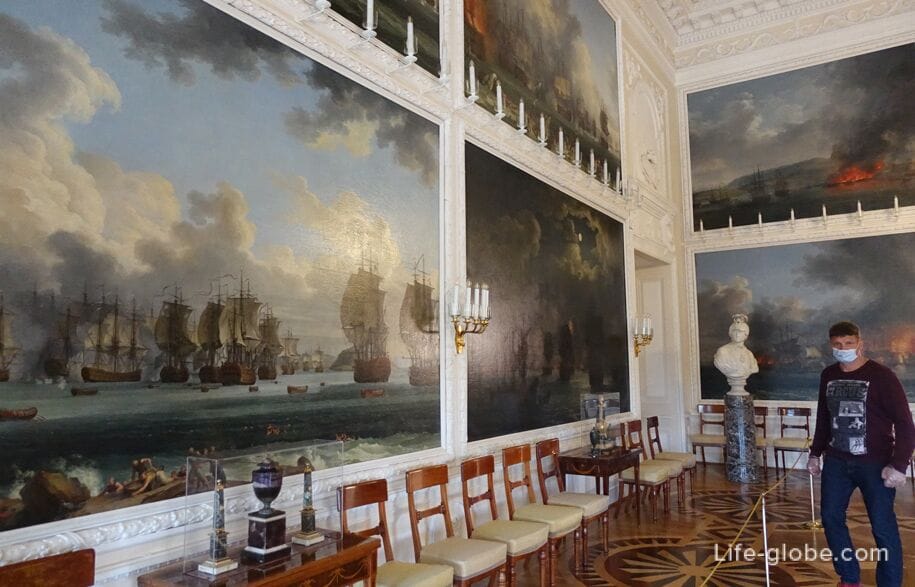
The commander of the entire operation in the Mediterranean Sea was Count Alexey Orlov, whose bust, by the Italian sculptor Giovanni Cibei, is in the hall. Giovanni depicted Orlov in the form of the ancient god of war Mars with the highest military order of Russia "St. George of the first degree" on his chest. This Order of the Eagles was awarded for the Chesma victory.
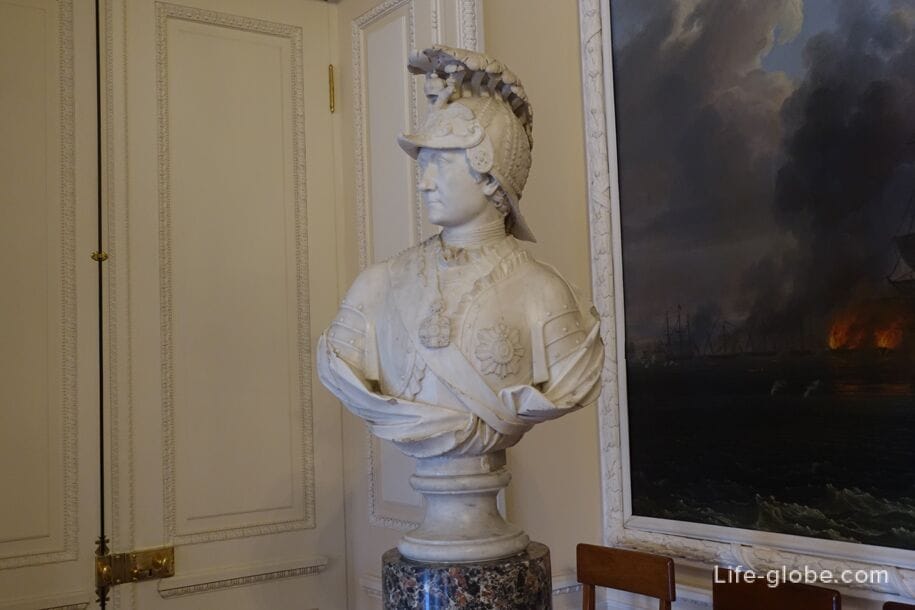
A small room that got its name from the decoration of the walls, covered with a blue silk damask.
This duty room served as a kind of clerical office; there was always a secretary on duty, who recorded in a special journal everything that happened at court: the arrival or departure of important persons, couriers, as well as the arrival of furniture, etc.
The museum's current exhibition in the Blue Reception Room features mid-19th-century furniture in the "second Baroque" style, bronze products and vases from the Imperial Porcelain Factory in the Empire style. The walls are decorated with paintings, one of the works by I. K. Aivazovsky with the Peterhof landscape ("View of the Grand Palace and the Grand Cascade").
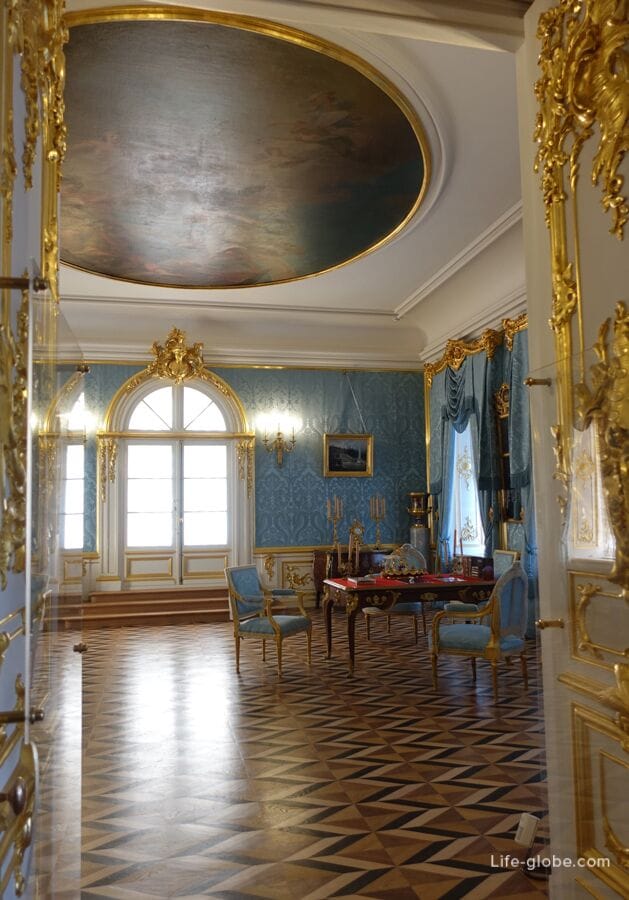
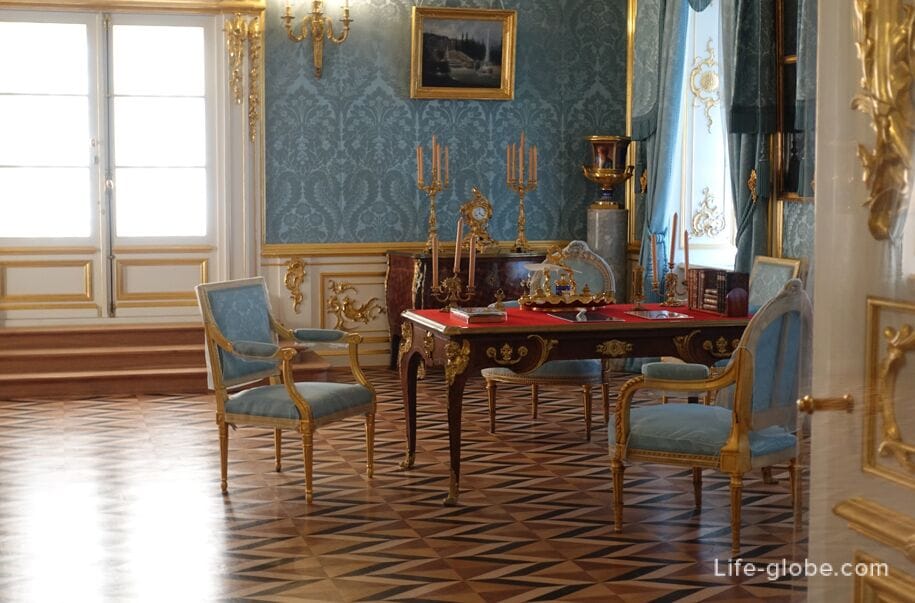
This is the largest hall of the Peterhof Palace, where the most solemn receptions were held and ambassadors were received.
By the decree of Catherine II, architect Yuri Felten designed the hall in the style of classicism-the predominance of white color and monumental stucco decoration: large stucco ornaments made of acanthus leaves on the padugas, oak and laurel leaves (symbols of perseverance and glory), wreaths and garlands.
In the hall there are large chandeliers with crystal pendants, stylized in the form of oak leaves. The chandeliers are all authentic, works of the 18th century-they were brought to Leningrad in 1941 and preserved during the Second World War. During the siege of Leningrad, the chandeliers were located in the basements St. Isaac's Cathedral.
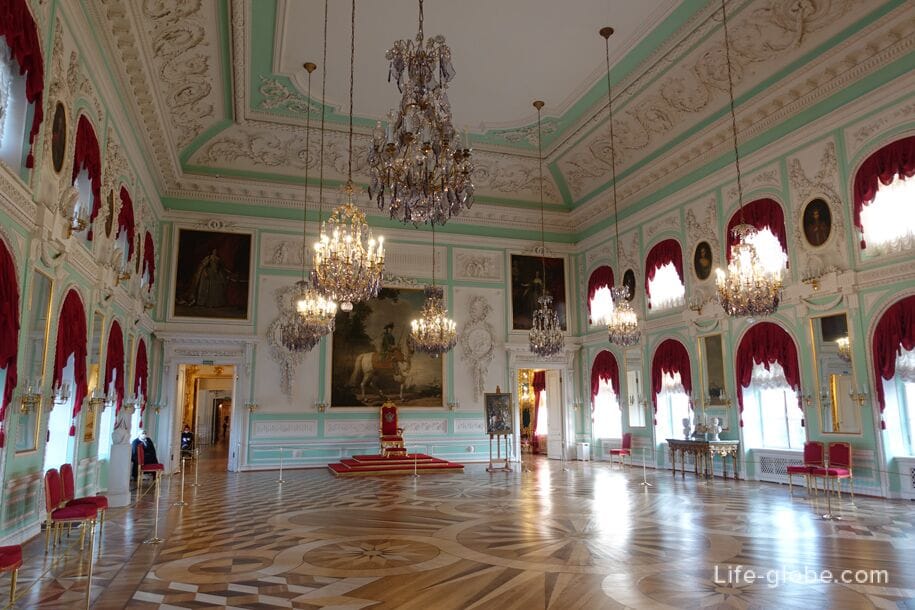
The walls of the hall are decorated with paintings, including those dedicated to the Battle of Chesma.
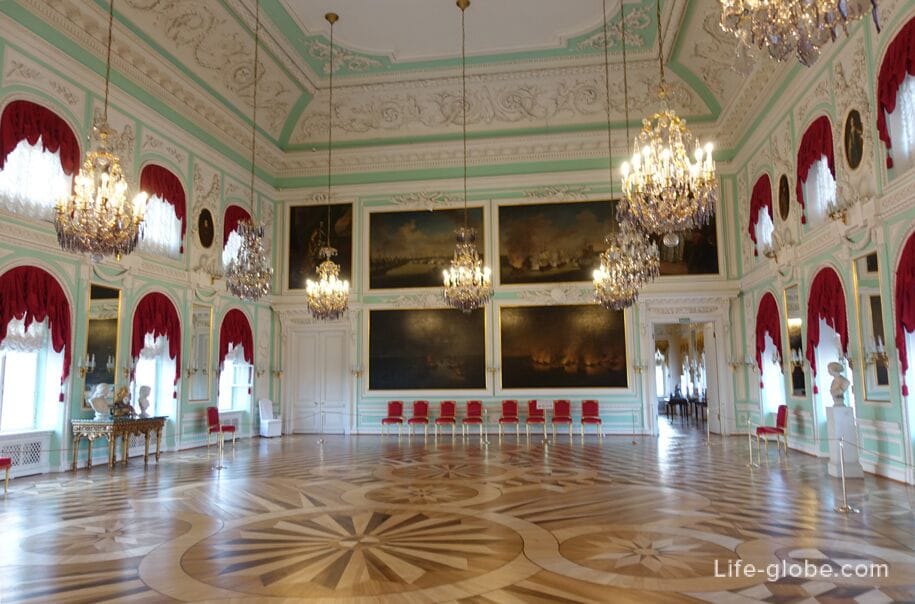
The main place in the hall is a throne seat with a throne chair. The chair itself was in different palaces, but the footstool near the chair has been in the hall since the middle of the 18th century.
Above the throne chair, the wall is decorated with a ceremonial portrait of Catherine II, who in a male military suit sits on a white horse "Diamond" and in this form she rode from Peterhof to St. Petersburg, appeared before the guards and took the throne with a coup.
If Catherine was not the Empress of Russia by blood, then she definitely wanted to prove her unity in spirit. At her behest, portraits of her predecessors on the throne are placed in the hall, and in the medallions - portraits of relatives of the family of Peter I, including Tsarevich Alexei, who died in the walls Peter and Paul Fortress, accused of high treason; there is only the grandson of Peter I (the husband of Catherine II) - the Emperor Peter III.

This is one of the small front rooms of the palace, made in the Baroque style of Rastrelli, which is also called Elizabethan or Russian Baroque.
In the hall there are characteristic gilded wooden carvings with floral ornaments and mirrors.
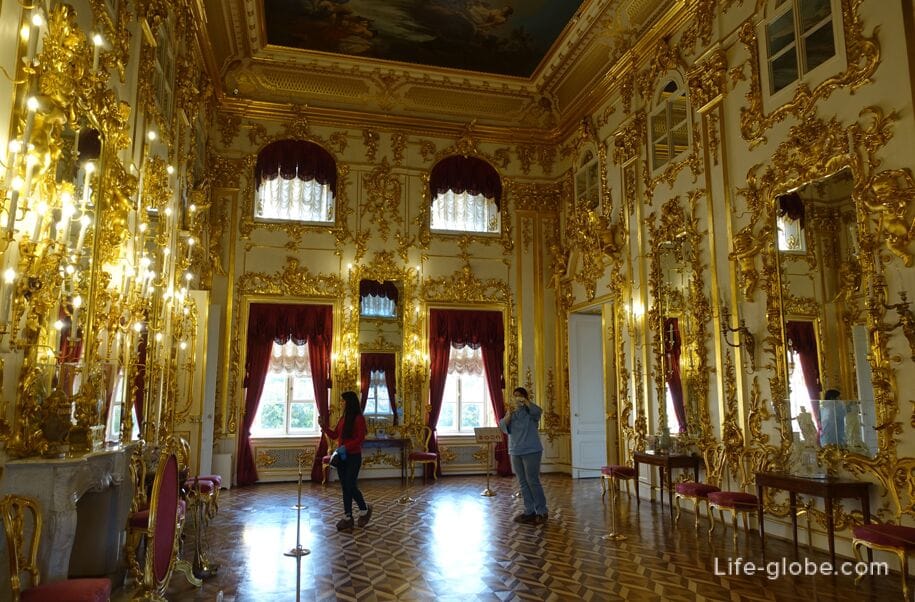
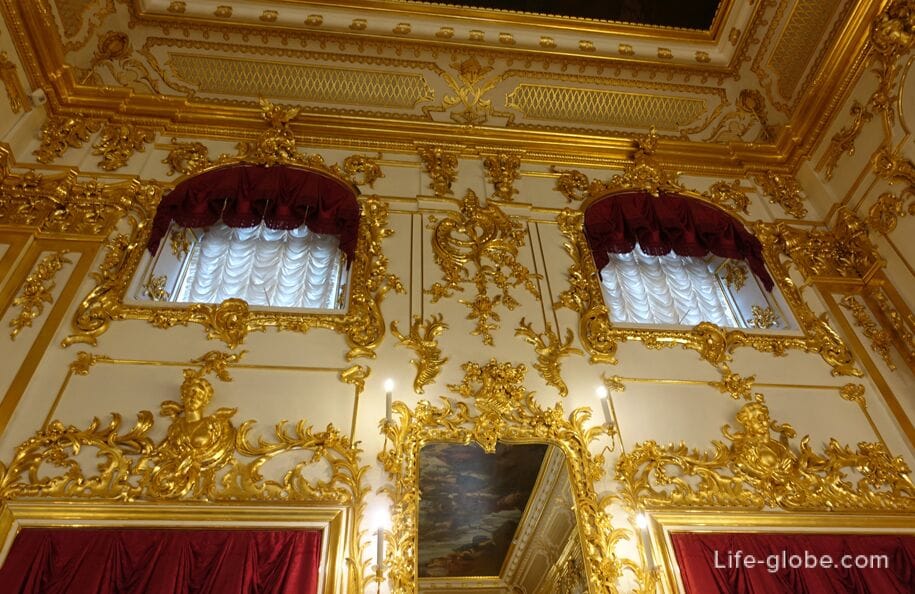
Above the doorways are sculptures of "putti angels", in the hands of which are unusual objects: gardening tools, wood carvers, musical instruments and navigation devices. Such an image glorified Russia, where science, art and crafts flourished; after all, the 18th century is the age of allegory.
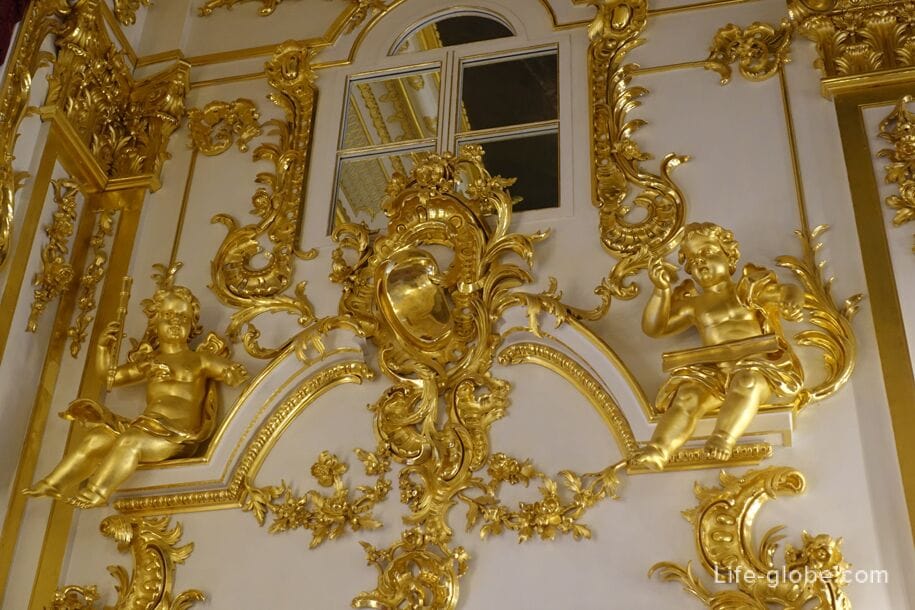

On the ceiling of the hall in the ceiling lamp, Paulo Ballarini captured the poem "Jerusalem Liberated" by Torquato Tasso, with the plot when true love overcomes obstacles.
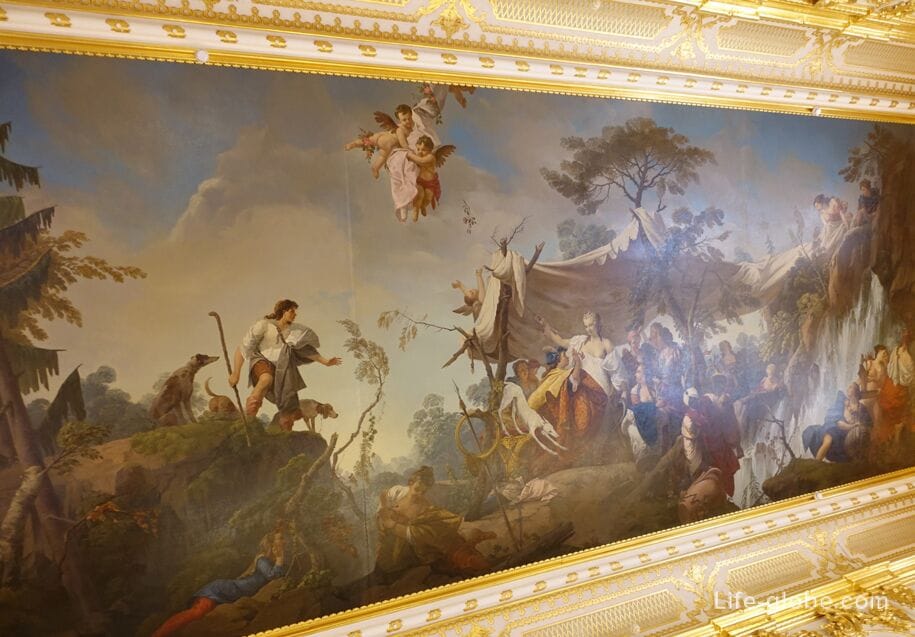
Along the walls of the hall there are wooden tables, at which in the 18th century they could spend their leisure time. "Leisure" then is a game of cards.
Peter I did not like gambling and under him a decree was issued that forbade losing more than 1 ruble at cards. Elizabeth Petrovna loved card games and in order not to violate the will of her father, she came up with a little trick - by decree she divided all card games into gambling prohibited and commercial permitted; they played for money both here and there, but gambling included games where the winnings depended on the will of chance, and if the game had to use calculations (intellectual abilities), then it was already other money and the game did not belong to gambling.
Today, instead of cards and bets, which were also diamonds under Catherine II, there are museum exhibits-vases, porcelain figurines that were made at the first porcelain manufactory in the city of Meissen in Germany.
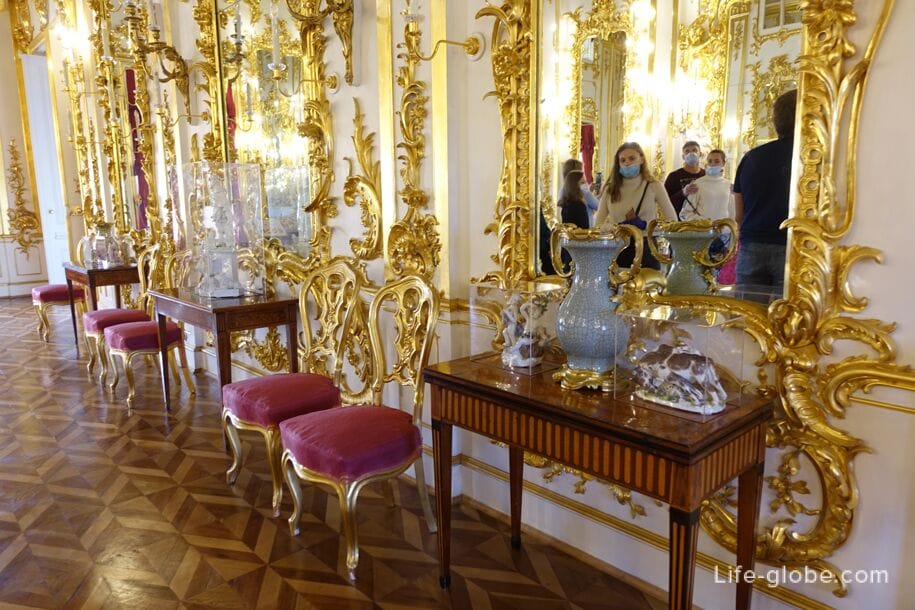
In the hall, the clock on the mantelpiece is interesting, in which the sculpture of a woman is an allegory of history, which looks in the mirror and in which the profile of Catherine II is depicted.
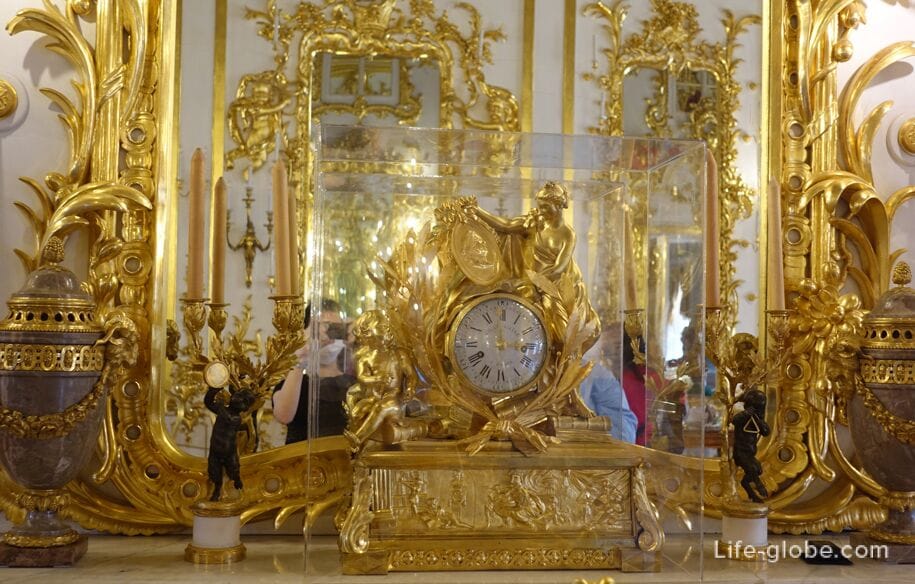
The hall was used for small state receptions.
This hall has another name - Stats-damskaya. At large ceremonial dinners and suppers, when there were not enough seats in the great hall, tables were set in other state halls of the palace. In this hall, the place of the retinue of the empress (state ladies) was assigned, from which the hall received its second name.
The dining room is decorated in light colors, classic style and decorated with wall bas-reliefs.
Chandeliers in the hall of the 18th century. Such chandeliers are called amethyst, because they have a grayish hue, similar to the amethyst stone.


The dining room table is decorated with Wedgwood china (or Husk-service) cream-colored porcelain with a delicate floral pattern of lilac-lilac color. Made at the Etruria plant in Staffordshire by J. Wedgwood.
The service was originally ordered by Catherine II in 1768. The service was received in 1779 and included about 1,500 items. Over time, the dishes were broken and partially replenished at the expense of copies created in Russian manufactories. Now the hall is showing a set of 30 couverts of 196 items.
Court lunches or dinners in the 18th and 19th centuries were ceremonial in nature and lasted for several hours; the menu included several changes of dishes, and sometimes there were only 5-6 soup dishes: tortoiseshell, herring cheek soup, which required several thousand herring.
So that the dishes would not cool down during conversations, the plates were placed on the stands of the "vodyanitsa", which were filled with boiling water.
In the center of the table is a vase-aroma bowl, in which spicy herbs were placed for a pleasant aroma. On the left and right of the aroma bowl are tall vessels - these are ice cream makers; and then ice cream was the main dish, which was served together with soups and hot and ice cream was not always sweet.

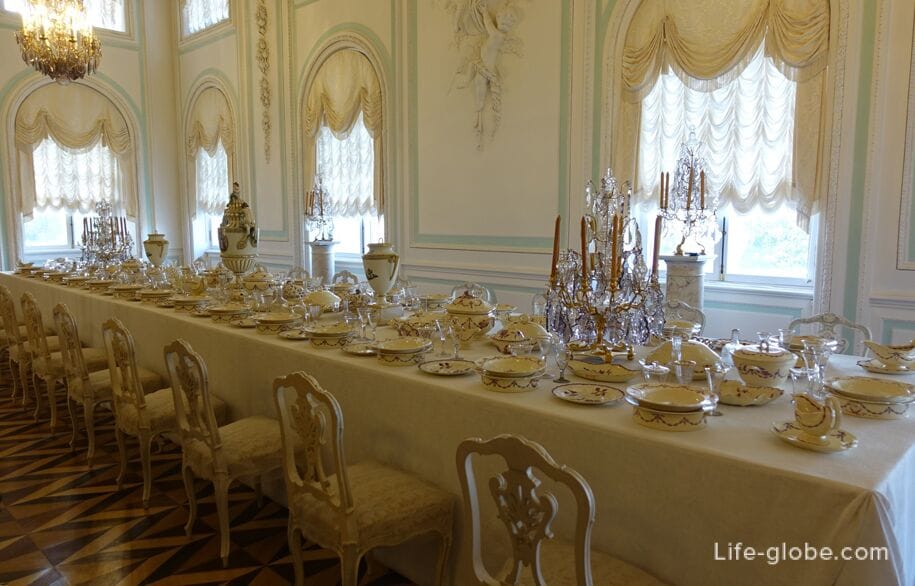
The hall features round stoves made of Russian-made white glazed tiles. Initially, they were made according to Felten's sketches. Broken during the war, the furnaces were restored in the post-war years by V. Zhigunov, A. Povarov and V. Pavlushin.


Adjacent to the White Dining Room are two small service rooms-canteens, where food was heated and replaced dishes were stored, since there were no kitchens in the palace. The kitchen was a detached building.
Now in the room there is an exhibit of the museum-the original coronation chair of Emperor Nicholas I.
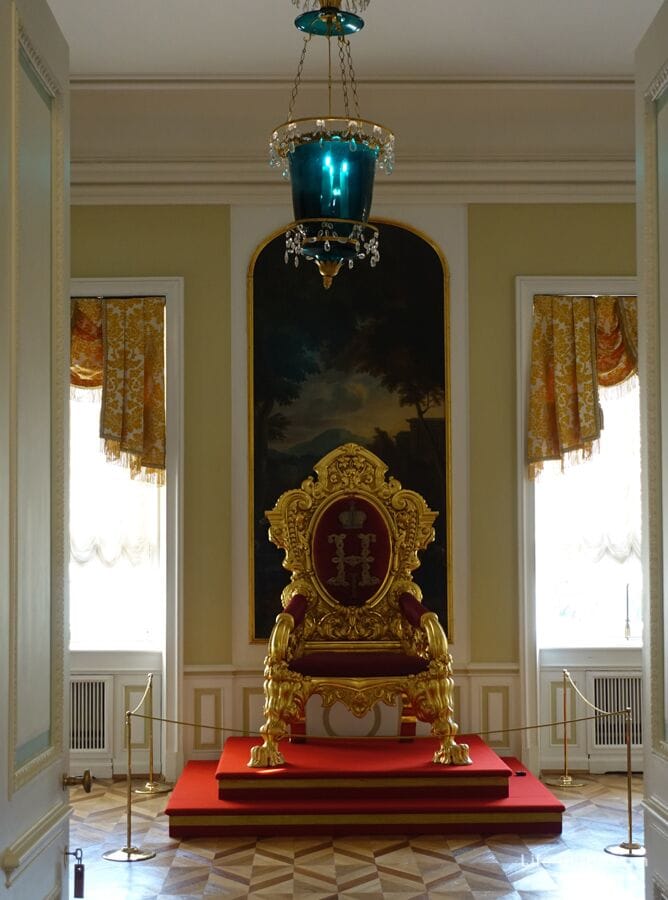
Catherine II loved to surprise her guests not only with food and events, but also by her order in the Great Peterhof Palace, architect J. B. Wallin-Delamotte created two small Chinese cabinets that were strikingly different in style,and the hostess showed them to the guests.
In the halls there were works of oriental art, Chinese porcelain, which was then very expensive and spoke of luxury, panels, two of which are from the 18th century, Chinese screens, which were brought from China with paintings on black lacquer with gold and silver.

This is the central grand hall of the Peterhof Palace, which has repeatedly changed its appearance during its history.
Initially, it was the largest and most solemn palace room in which Peter the Great hosted receptions. Peter especially liked the view from the window, through which the Sea Channel of the Lower Park of the palace is visible.
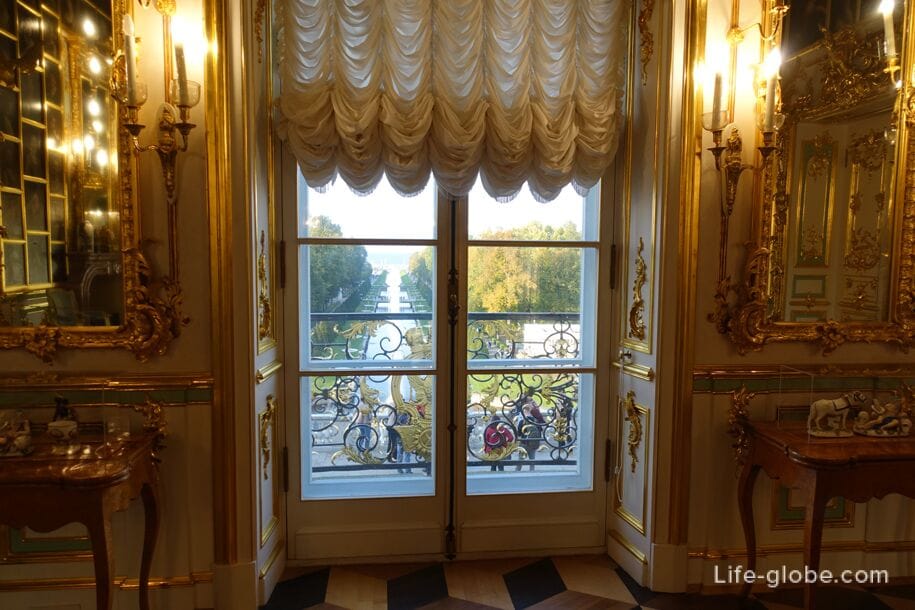
The walls of the hall are decorated with paintings by one artist Pietro Rotary. The artist was an Italian, worked in St. Petersburg and his paintings were very popular with Catherine II. When the artist died, Catherine ordered to buy everything that remained in St. Petersburg.
In the hall there are mainly portraits of girls in national clothes. You can see the image of a girl, and next to a more adult woman-so the artist tried to imagine how a young virgin will look many years later.
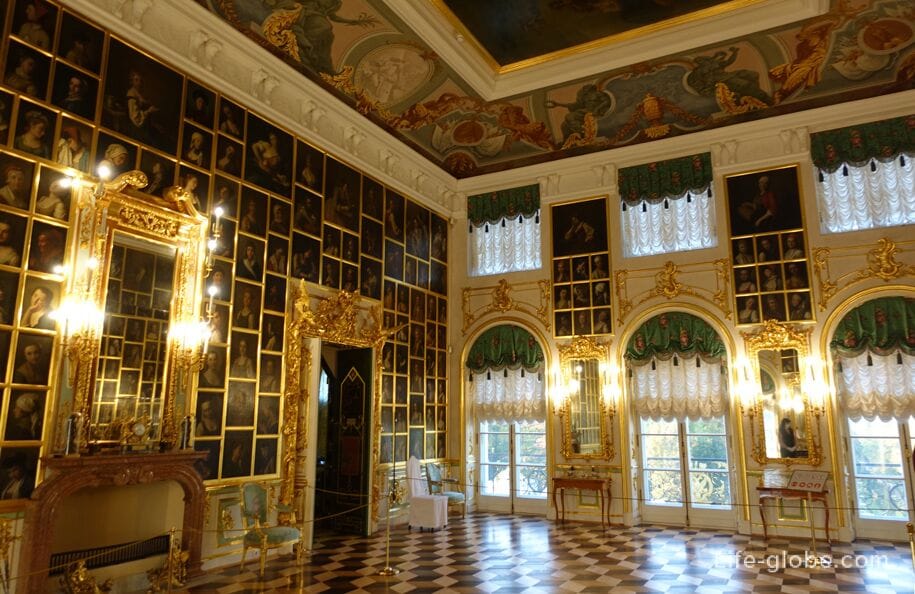

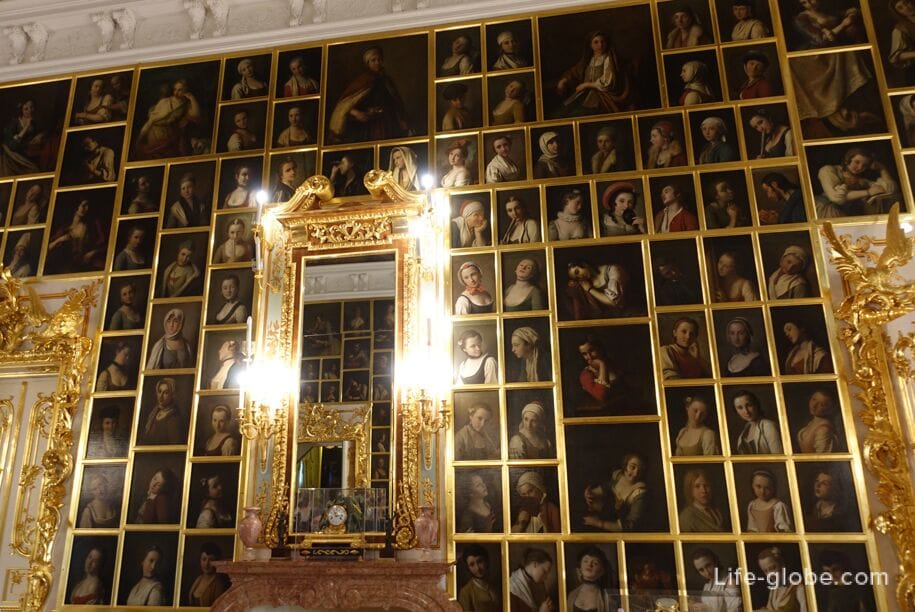
The ceiling of the hall

The picture hall closes the enfilade of the main halls of the palace and draws the line between the official halls and the private palace rooms-the living male and female halves.
Private rooms include:
- The partridge parlor, or boudoir, which opens the suite of rooms of the female half of the palace. The room was used for the morning entertainment of the empresses in their immediate surroundings.
The name" Partridge " room was due to the walls - a pale blue silk fabric with a silver tint with woven images of partridges, inscribed in an ornament of flowers and wheat ears;

- Sofa - bedchamber of the empresses, to which the Dressing Room adjoins;

- The Empress ' study, where the mistress often played cards, was kept in a close circle;
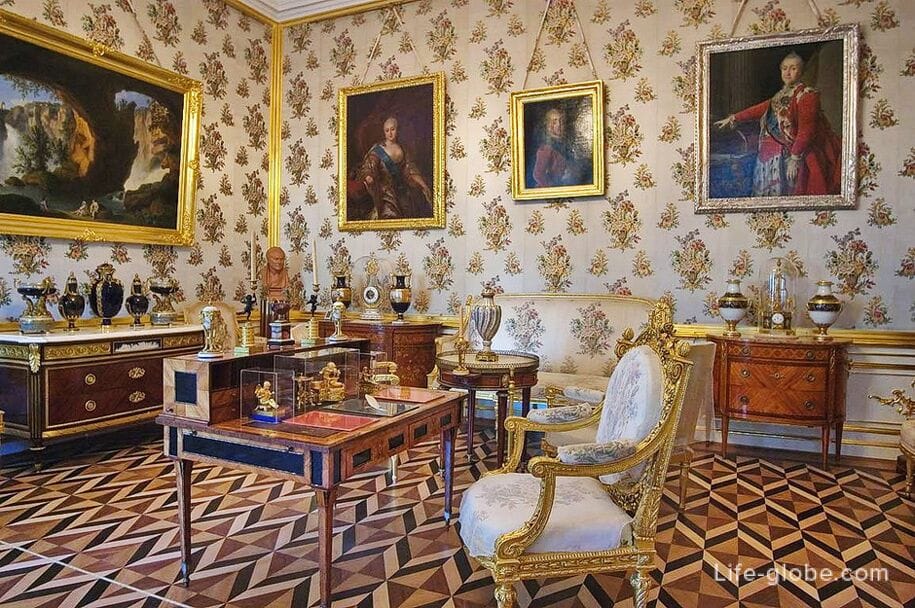
- Standard room, where the standards of the guards regiments were once kept;
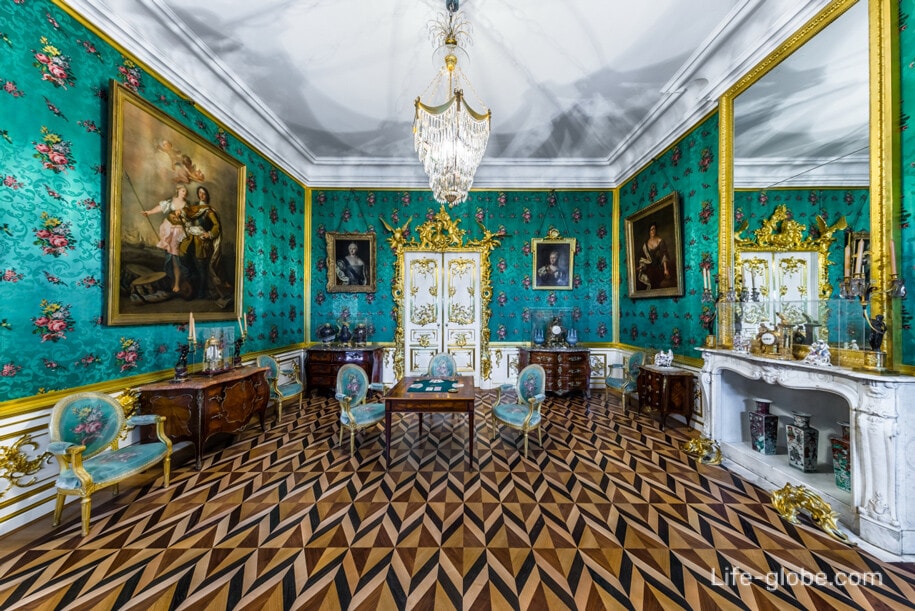
- Cavalry, which was intended for the guard of the cavalry guards and where the presentation of the cavaliers of the Russian orders was also made and the receptions of the officers of the guards regiments were arranged;

- A large blue drawing room, which was changed several times and in the early 18th century was called the dining room, since the room was used as a family dining room.
The living room is decorated with ceremonial portraits of Catherine II and Paul I's wife Maria Feodorovna. The interior is complemented by a stove with so-called "landscape" tiles. And the center of the exhibition of the living room is a Banquet set for 250 people, made at the Imperial Porcelain Factory in the middle of the 19th century. This masterpiece was taken out during the Great Patriotic War, and discovered in East Prussia, and then returned to his homeland. In addition, there are large vases and chandeliers for 86 candles, as well as two cabinets decorated with bronze;
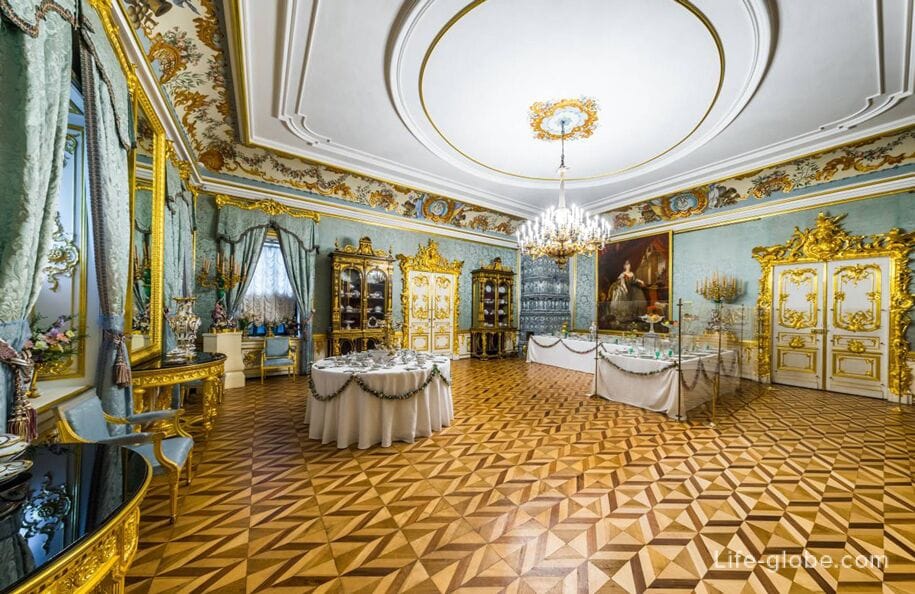
- The crown-the state bedchamber, which was not used for its intended purpose.
Since the end of the 18th century, the room has been called the "Crown", since in the reign of Paul I, a special "parking lot" for the crown was installed in the room;
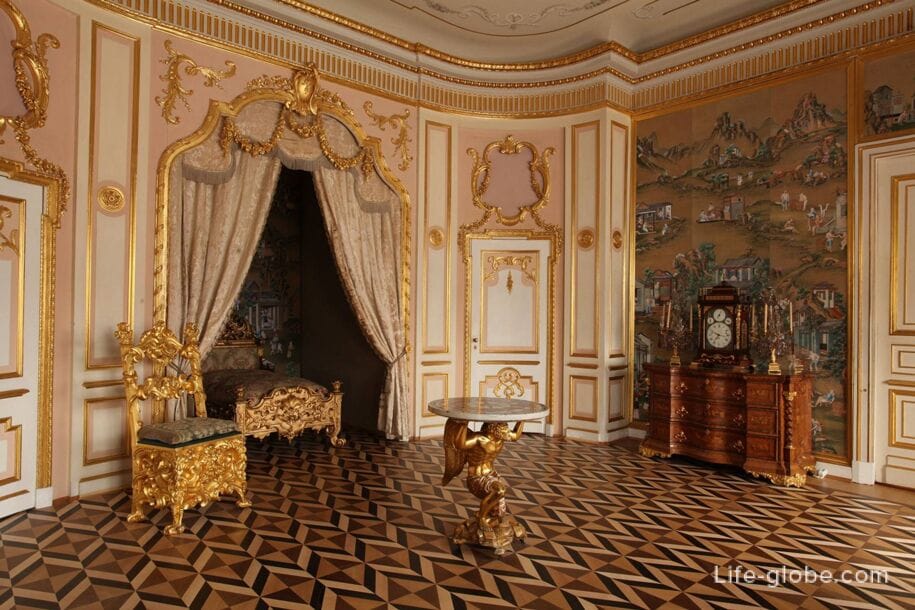
- The Oak study of Peter I and the Oak Staircase.
The oak study is the oldest interior of the palace, which was created in the first quarter of the 18th century. It is decorated with fourteen oak panels, eight of which are authentic.
The oak staircase was built in 1720-1721 by A. Leblon. The plafond was created by I. Ya. Vishnyakov in 1751 and depicted Aurora, the goddess of the dawn; it was lost during the war and recreated in 1964 by Ya. A. Kazakov. The steps of the staircase are covered with oak, and the balusters of the staircase railing are also carved from it-hence the name.

On the ground floor of the palace is the so-called sculpture gallery of the palace, located in the lobby and where an authentic collection of sculptures from the 18th century is presented. Sculptures that once decorated the parks and fountains of the palace complex.
In the hall you can also watch a short film about Peterhof.
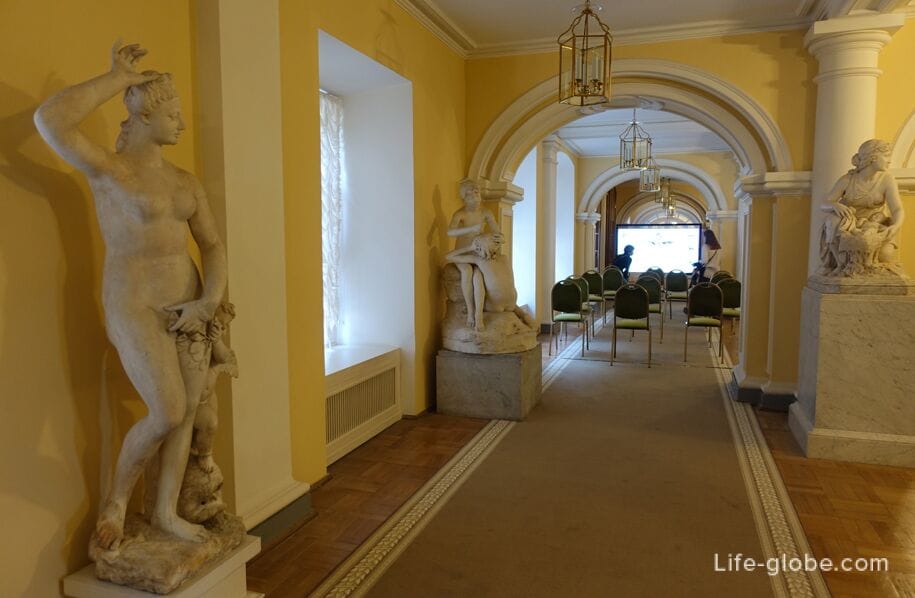
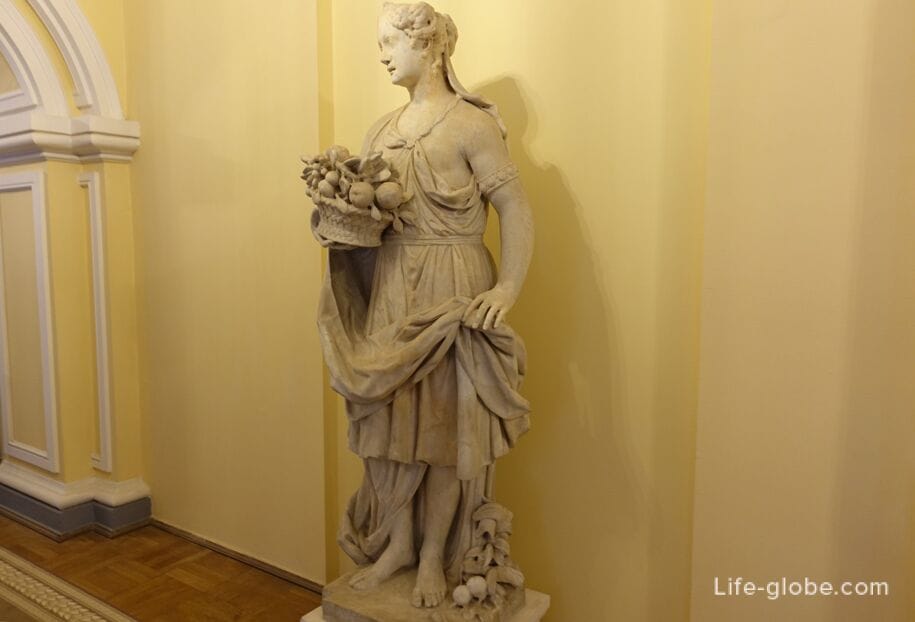
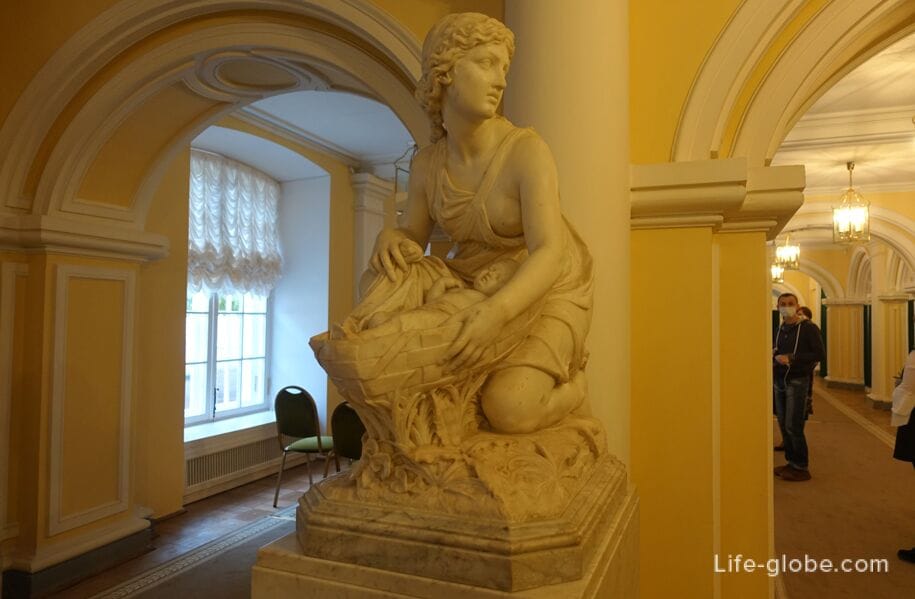

The Grand Peterhof Palace, together with the Upper Garden and the Lower Park, is part of the Peterhof Palace and Park Ensemble and belongs to the Peterhof State Museum-Reserve.
The halls of the Grand Peterhof Palace can be visited for a fee as part of excursions. Entrances to the palace parks are also paid.
All or part of the halls of the palace may be open to the public. Some exhibits in the halls may also change.
Tickets can be purchased in advance online or at the ticket office near the palace.
The opening hours of the museum in the palace, the cost of tickets, as well as the conditions for visiting and buying tickets, we recommend that you check directly before visiting the official website.
Website of the State Museum-Reserve "Peterhof": peterhofmuseum.
You can visit Peterhof with one of the excursions
All the ways to get to Peterhof from St. Petersburg (the airport and the city center) can be found here →
Near the Palace and Park Ensemble "Peterhof" you can stop
The 4-star Novy Peterhof Hotel features a restaurant, bar, parking, tour desk, spa area with indoor pool, gym, steam bath, Finnish cedar sauna and aroma sauna.
The modern-style rooms at the hotel are equipped with a TV with satellite channels, free Wi-Fi, a safe, bathrobes and slippers, a hairdryer and free toiletries. Some rooms have a seating area.
The room rate can include: breakfast, breakfast + dinner or breakfast + lunch + dinner. Link to the hotel
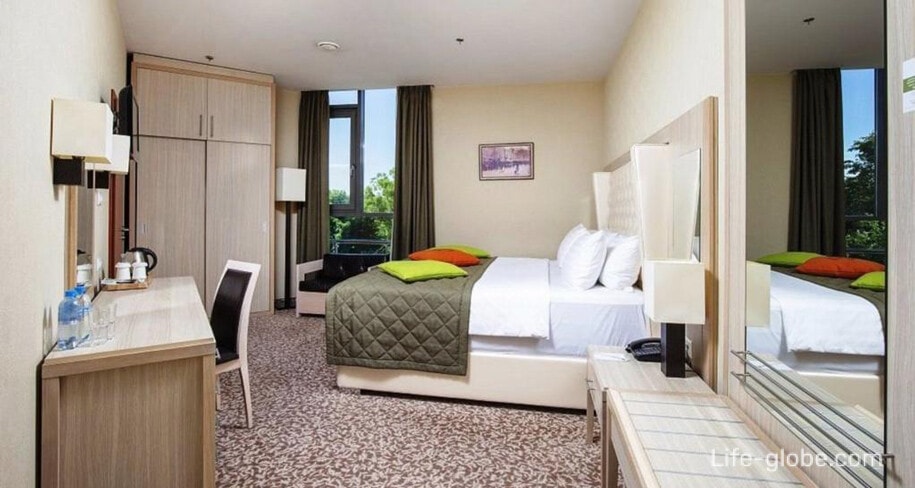
EGO-LOFT Apartment (Holgin Pond) they offer views of the lake and the city.
In the apartment: air conditioning, balcony, free Wi-Fi, flat-screen TV, washing machine, bedroom, kitchen with dishwasher and microwave, bathroom with hairdryer and free toiletries. Link to the apartment
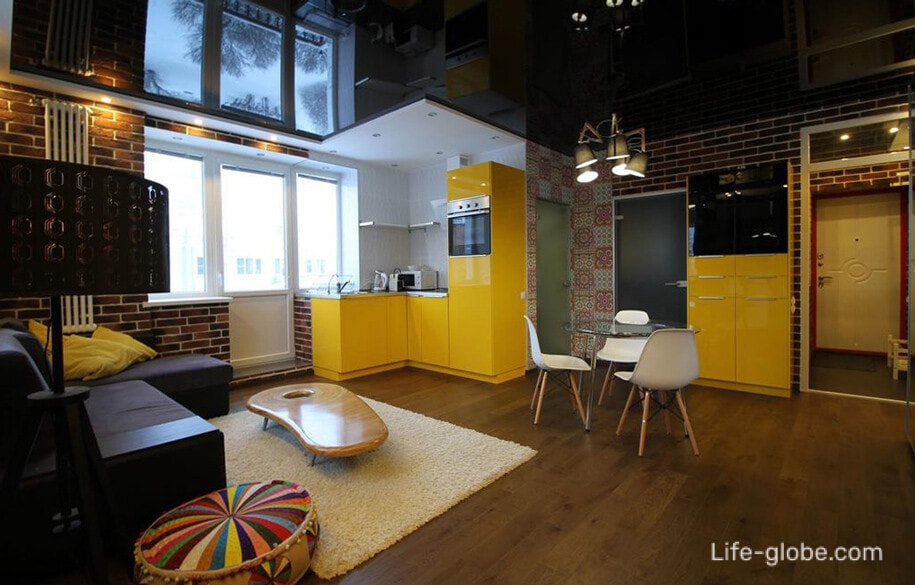
Featuring a balcony with lake views, Severnaya Venezia offers free Wi-Fi, a children's playground, a garden and a shared lounge.
The apartmentfeatures a bedroom, a flat-screen TV with cable channels, an equipped kitchen with a microwave and a refrigerator, a washing machine, and a bathroom with a shower. Link to the apartment
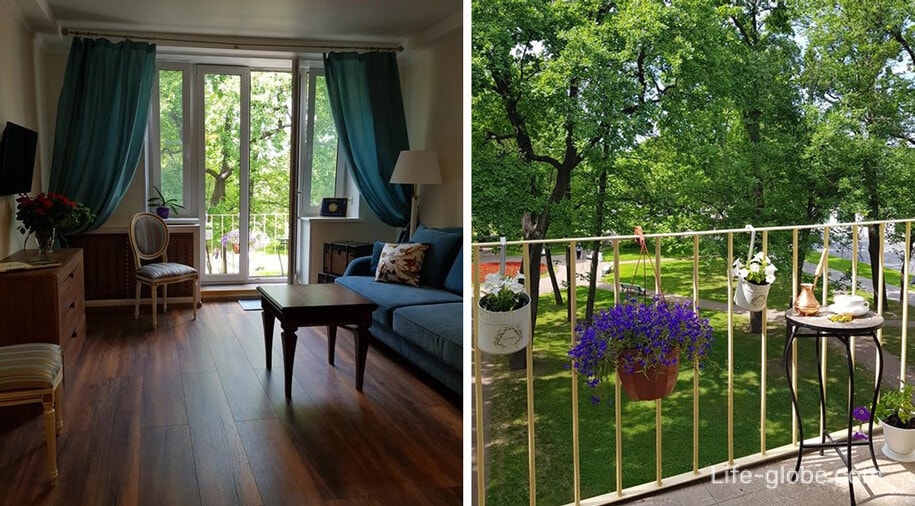
All accommodation facilities in St. Petersburg, including in the city center and in Peterhof, can be viewed and booked here